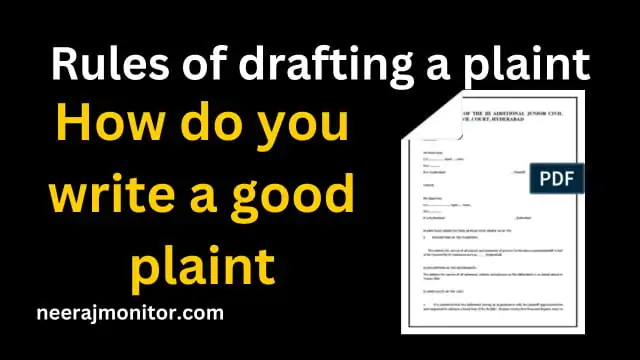Introduction: Rules of drafting a plaint
In the realm of legal writing, the ability to craft a compelling and persuasive plaint is a skill that sets apart adept attorneys from the rest. A plaint, which serves as the initial pleading in a civil lawsuit, lays the foundation for the entire legal process. In this guide, we will delve into the nuances of writing a plaint that not only meets the legal requirements but also captivates the reader and builds a strong case.

Understanding the Basics: Rules of drafting a plaint
Before delving into the intricacies of writing a plaint, it’s essential to grasp the basics. A plaint typically includes the following elements:
- Caption: This includes the names and contact information of the parties involved.
- Introduction: A concise statement introducing the case and the jurisdiction.
- Facts: A clear and chronological presentation of the events leading to the legal dispute.
- Legal Claims: The specific legal claims or causes of action being asserted by the plaintiff.
- Prayer for Relief: The remedy or relief sought by the plaintiff from the court.
Crafting a Captivating Narrative: Rules of drafting a plaint
While the legal content is paramount, presenting it in a compelling narrative can significantly enhance the impact of your plaint. Consider the following tips:
- Clarity is Key: Use clear and concise language to convey your points. Avoid legal jargon that might confuse the reader.
- Chronological Storytelling: Present the facts in a chronological order to create a seamless and easy-to-follow narrative.
- Humanize Your Client: Share relevant details about your client that make them relatable. This could include personal challenges, aspirations, or the impact of the legal issue on their life.
- Paint a Vivid Picture: Use descriptive language to evoke emotions. Help the reader visualize the events and understand the context.
Meeting Legal Requirements : Rules of drafting a plaint
While creativity is encouraged, it’s crucial to adhere to the legal requirements of a plaint. Failure to do so can lead to dismissals or delays. Here are some key considerations:
- Specificity of Allegations: Ensure that your allegations are specific and clearly identify the actions that form the basis of your claims.
- Legal Citations: Support your legal claims with relevant statutes, precedents, and legal principles. This strengthens the legal foundation of your plaint.
- Proper Formatting: Follow court guidelines regarding formatting. This includes font size, margins, and line spacing.
- Verification and Signature: Most jurisdictions require a plaint to be verified, meaning it must be signed by the plaintiff or their attorney under oath.
Strategic Use of Language: Rules of drafting a plaint
Choosing the right words can make a significant difference in how your plaint is perceived. Consider the following language strategies:
- Avoid Hyperbole: While it’s essential to create a compelling narrative, avoid exaggerations or hyperbole. Stick to the facts to maintain credibility.
- Use Active Voice: Opt for active voice over passive voice to create a sense of immediacy and responsibility.
- Emphasize Legal Significance: Clearly articulate the legal significance of the events described. Connect the facts to the relevant legal principles.
- Balance Emotion and Objectivity: Strike a balance between emotional appeal and legal objectivity. Emotional language can be powerful but should not overshadow the legal arguments.
The Importance of Thorough Research: Rules of drafting a plaint
A well-researched plaint is a potent weapon in the legal arsenal. Conduct extensive research to gather relevant facts, precedents, and legal arguments. This not only strengthens your case but also demonstrates your commitment to diligence and preparedness.
- Legal Precedents: Identify and reference legal precedents that support your claims. This provides a basis for the legal validity of your arguments.
- Statutory Authority: Clearly cite relevant statutes and legal provisions. This establishes the legal framework for your case.
- Counterarguments: Anticipate potential counterarguments and address them proactively in your plaint. This showcases your foresight and legal acumen.
Conclusion: Rules of drafting a plaint
In conclusion, writing a plaint is not merely a procedural requirement; it’s an opportunity to advocate for your client and set the stage for the legal proceedings to come. By mastering the art of persuasion through clear, compelling narratives, adherence to legal requirements, strategic language use, and thorough research, you can elevate your plaint from a routine document to a powerful instrument that lays the groundwork for a successful legal case. Remember, each word you choose carries weight in the courtroom, so choose them wisely.
Read Also:
How to Choose Most Profitable Business Field with Full Case Study
